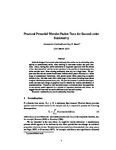Practical powerful wavelet packet tests for second-order stationarity
| dc.contributor.author | Cardinali, Alessandro | |
| dc.contributor.author | Nason, GP | |
| dc.date.accessioned | 2018-11-27T12:00:53Z | |
| dc.date.available | 2018-11-27T12:00:53Z | |
| dc.date.issued | 2018-05 | |
| dc.identifier.issn | 1063-5203 | |
| dc.identifier.issn | 1096-603X | |
| dc.identifier.uri | http://hdl.handle.net/10026.1/12910 | |
| dc.description.abstract |
Methods designed for second-order stationary time series can be misleading when applied to nonstationary series, often resulting in inaccurate models and poor forecasts. Hence, testing time series stationarity is important especially with the advent of the ‘data revolution’ and the recent explosion in the number of nonstationary time series analysis tools. Most existing stationarity tests rely on a single basis. We propose new tests that use nondecimated basis libraries which permit discovery of a wider range of nonstationary behaviours, with greater power whilst preserving acceptable statistical size. Our tests work with a wide range of time series including those whose marginal distributions possess heavy tails. We provide freeware R software that implements our tests and a range of graphical tools to identify the location and duration of nonstationarities. Theoretical and simulated power calculations show the superiority of our wavelet packet approach in a number of important situations and, hence, we suggest that the new tests are useful additions to the analyst's toolbox. | |
| dc.format.extent | 558-583 | |
| dc.language | en | |
| dc.language.iso | en | |
| dc.publisher | Elsevier BV | |
| dc.subject | Stationarity test | |
| dc.subject | Local stationarity | |
| dc.subject | Bootstrap | |
| dc.title | Practical powerful wavelet packet tests for second-order stationarity | |
| dc.type | journal-article | |
| dc.type | Journal Article | |
| plymouth.author-url | https://www.webofscience.com/api/gateway?GWVersion=2&SrcApp=PARTNER_APP&SrcAuth=LinksAMR&KeyUT=WOS:000428834200003&DestLinkType=FullRecord&DestApp=ALL_WOS&UsrCustomerID=11bb513d99f797142bcfeffcc58ea008 | |
| plymouth.issue | 3 | |
| plymouth.volume | 44 | |
| plymouth.publication-status | Published | |
| plymouth.journal | Applied and Computational Harmonic Analysis | |
| dc.identifier.doi | 10.1016/j.acha.2016.06.006 | |
| plymouth.organisational-group | /Plymouth | |
| plymouth.organisational-group | /Plymouth/Faculty of Science and Engineering | |
| plymouth.organisational-group | /Plymouth/Faculty of Science and Engineering/School of Engineering, Computing and Mathematics | |
| plymouth.organisational-group | /Plymouth/REF 2021 Researchers by UoA | |
| plymouth.organisational-group | /Plymouth/REF 2021 Researchers by UoA/EXTENDED UoA 10 - Mathematical Sciences | |
| plymouth.organisational-group | /Plymouth/REF 2021 Researchers by UoA/UoA10 Mathematical Sciences | |
| plymouth.organisational-group | /Plymouth/Users by role | |
| plymouth.organisational-group | /Plymouth/Users by role/Academics | |
| dcterms.dateAccepted | 2016-06-19 | |
| dc.identifier.eissn | 1096-603X | |
| dc.rights.embargoperiod | Not known | |
| rioxxterms.versionofrecord | 10.1016/j.acha.2016.06.006 | |
| rioxxterms.licenseref.uri | http://www.rioxx.net/licenses/all-rights-reserved | |
| rioxxterms.licenseref.startdate | 2018-05 | |
| rioxxterms.type | Journal Article/Review |


